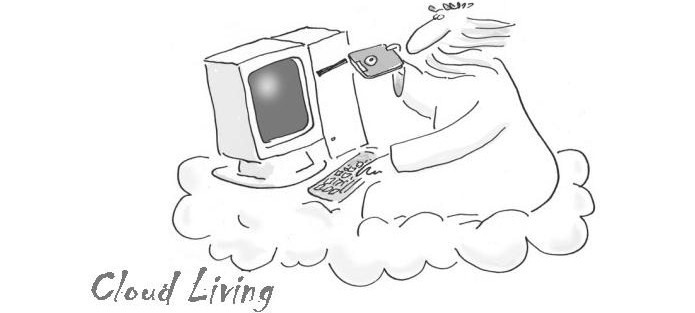Cloud Living – Cloud Computing Solutions

So far we have talked about cloud computing from a business standpoint, but the fact is that, by its rapid adoption and the types of services we consume, the cloud is also present in our daily lives.
Many technological advances reach the homes after their development in the business world since the initial investment in new technology is high. The personal computer is a good example: It began to be seen in homes after years of exclusivity in business. However, the cloud computing solutions model is being taken quickly by the general public as it does not offer an economic barrier to enter and its benefits are obvious:
Easy to access and share data centrally between different people and devices (office computer and at home, smartphone, tablet).
Increased reliability and ease of maintenance of information: No longer rely on a physical medium that we maintain and we do regular backups (we all do that, don’t you?). If the disc on my PC corrupts or if I lose my iPhone, I keep my contacts, photos and important documents in the cloud for better safety.
Access to media (music, videos, etc.) without physically having them either on CD or USB.
Accessing applications without requiring the installation of software on your machine. This not only reduces spending on software but also the hardware requirements to run the applications, since this is running on the server and we see the result. (Media as a Service?).
Avoid Constant Update: No need to constantly install new versions of the programs we use and update our computer or game console to enjoy. The service provider takes care of this while we agree with customers “light” (eg, a browser).
Obviously, the particular use conditions are not the same as a business. Although a company has a motivation and economic power, their risk, possible changes to its business model and regulatory standards in data protection slow down cloud adoption globally. The road to enterprise adoption, nevertheless, you can start with some small steps to minimize risks and costs and serve to strengthen the transition to more ambitious goals. But we’ll talk about this in another post.
Returning to the home, we can classify the services offered by the different cloud types. Some of them are shared with the corporate level while others are private.
Data storage: In the same way that a company uses an infrastructure service (Infrastructure as a Service), the home user also has the same options, which usually offer a free option that can be improved further to premium versions. Some examples of these services: Dropbox, Google Docs, iCloud, eNlight, etc. These systems have the support of developers who integrate their applications with these storage systems. For more advanced users, it is possible to prepare your own private cloud infrastructure with the installation of a hard disk connected to the network (hdd network). This can be interesting if you need to store and share large amounts of information and do not want to pay for premium accounts.
Applications: For years, we enjoyed what is known as Software as a Service without knowing what it was. Applications that formerly residing on our PC and now we access from our browser. Examples are numerous: Google Docs, Picasa, Maps, etc.
Playing Media: Following applying fever “suffix” as a service to almost everything, we will use the term “Media as a Service” that provides media playback on the cloud. This service, unlike previous ones, is almost exclusively for the home user (obviously exclude companies whose business model is based on the distribution or exploitation of resources). We want to enjoy music or videos and do not need to have them in a physical format. This service is revolutionizing the business of producing labels and at the same time allow the diffusion of new independent values. Examples known to all: last.fm, YouTube, Metacafe, etc..
Games: Online games are with us for a while, and web pages or similar flash games, enjoy games that allow increasingly powerful with the installation of a plugin in the browser. Something more interesting in the Cloud Gaming has just landed in India. There are companies that allow you to run the game on the server while the user views the image streaming and lets you play generation game through the browser.
Socialization: We could not miss the social networks in this review (Facebook, Twitter, Linkedin, Google Plus and etc.). Our photos, thoughts, contacts and hobbies are stored on remote servers and manage applications through the browser. Probably many people no longer consider doing the same from their computer. The risk of losing everything or not enjoy the updated version of the application would weigh much.
After this brief review we can ensure that we have a part of our lives in the cloud more than we thought… What do you think?
- How Cloud Computing Is Changing The Labor Market - March 25, 2015
- Adopting Infrastructure as a Service Can be a Good Deal - March 17, 2015
- Will Virtualize? Take These Six Points Into Consideration - March 12, 2015

Excellent info about cloud in daily life..